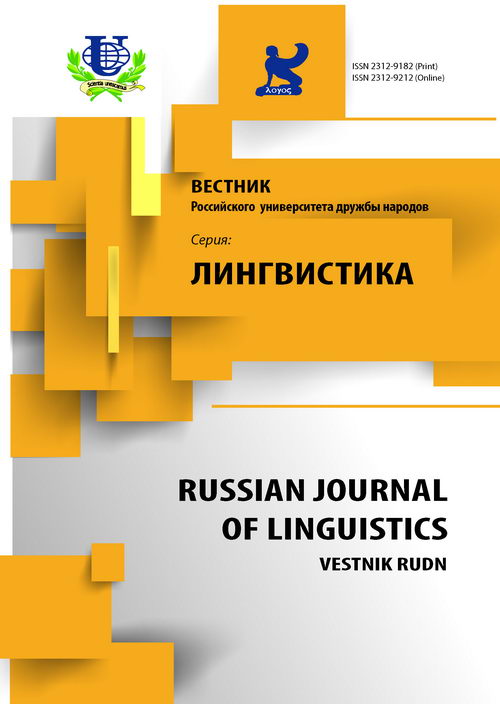Grammatical Means of Expressing Emotions in English Discourse
- Authors: Ozyumenko VI1
-
Affiliations:
- Peoples’ Friendship University of Russia
- Issue: No 1 (2015)
- Pages: 126-143
- Section: Articles
- URL: https://journals.rudn.ru/linguistics/article/view/9409
- ID: 9409
Cite item
Full Text
Abstract
Peculiarities of expressing emotions in different languages and cultures are nowadays of great interest among researchers. However, traditionally, more attention is paid to lexis, phraseology, prosody, and nonverbal signs of communication and grammatical means are ignored. Nevertherless, they also possess significant emotive potential. The goal of this article is to systematize some facts showing that grammar can implicitly convey various emotions of the speaker and impact the hearer, as well as to draw attention of language teachers and translators to this phenomenon. I will mainly focus on modal verbs and expressions, nontraditional use of tenses, nontraditional use of some adverbs, inverse word order and some other cases summing up the earlier described facts (Ozyumenko 2005-2006, 2007) and supplementing them with new observations. The article emphasizes that discovering emotive implicature, i.e. implicit emotive intention of the speaker, and revealing its meaning is sine qua non for successful intercultural communication and equivalent translation. The data for the research were taken from English language text books, grammar books, dictionaries and fiction. The study implements contextual, definitive, pragmatic, discourse and contrastive analyses.
Keywords
About the authors
V I Ozyumenko
Peoples’ Friendship University of Russia
Email: vladimir@ozyumenko.ru
Department of Foreign Languages Law Faculty
References
- Виноградов В.В. О категории модальности и модальных словах в русском языке // Избр. тр.: Исслед. по рус. грамматике. М., 1975. Т. 2. С. 38-79.
- Джиоева О.А. Англосаксонский менталитет сквозь призму английского языка. М.: Издательство Московского университета, 2014.
- Ирисханова О.К. Игры фокуса в языке. Семантика, синтаксис и прагматика дефокусирования. М.: ЯСЛ, 2014.
- Красавский Н.А. Эмоциональные концепты в немецкой и русской лингвокультурах. Волгоград: Издательство «Перемена», 2001.
- Ларина Т.В. Выражение эмоций в английской и русской коммуникативных культурах // Язык и эмоции: личностные смыслы и доминанты в речевой деятельности: Сб. научных трудов. Волгоград: Издательство ЦОП «Центр», 2004. С. 36-46.
- Ларина Т.В. A smile opens many doors: эмоции в коммуникации и переводе // Мосты. Журнал переводчиков. 2006. № 4 (12). С. 50-55.
- Ларина Т.В. Категория вежливости и стиль коммуникации: сопоставление английских и русских лингвокультурных традиций. М.: Языки славянских культур, 2009.
- Озюменко B.И. Грамматическое выражение эмоций в английском языке // Вестник РУДН. Серия «Русский и иностранные языки и методика их преподавания». 2005-2006. № 1(3-4). С. 172-180.
- Озюменко B.И. Модальность и эмоции в английском языке // Вестник РУДН. Серия «Русский и иностранные языки и методика их преподавания». 2007. № 3. С. 92-98.
- Пешковский А.М. Русский синтаксис в научном освещении. 7-е изд. М., 1956.
- Филимонова О.Е. Язык эмоций в английском тексте (когнитивный и коммуникативный аспекты). СПб.: Издательство РГПУ им. А.И. Герцена, 2001.
- Шаховский В.И. Категоризация эмоций в лексико-семантической системе языка. Воронеж: Воронеж. гос. ун-т, 1987.
- Шаховский В.И. Лингвистическая теория эмоций. М.: Гнозис, 2008.
- Шаховский В.И., Карасик В.И. Эмотивность и модальность в семантике слова // Семантика слова и синтаксической конструкции: Сб. науч. тр. Воронеж: Изд-во Воронеж. ун-та, 1987. С. 31-38.
- Эмотивная лингвоэкология в современном коммуникативном пространстве: кол. монография. Волгоград: Издательство ВГСПУ «Перемена», 2013.
- Язык и эмоции: личностные смыслы и доминанты в речевой деятельности. Сб. научных трудов. Волгоград: Изд-во ЦОП «Центр», 2004.
- Alexander L.G. Longman English Grammar. Longman Group UK Ltd., 1988.
- Alexander L.G. Longman Advanced Grammar. Longman Group UK Ltd., 1993.
- Brown Penelope and Stephen D. Levinson. Politeness: Some universals in language usage. Cambridge: Cambridge University Press, 1987.
- Baker A. Ship or Sheep: An intermediate pronunciation course. Cambridge University Press, 1981.
- Fox K. Watching the English. The Hidden Rules of English Behaviour. London: Hodder, 2005.
- Hewings M. Advanced Grammar in Use. Cambridge University Press, 1999.
- Leech G., Larina T. Politeness: West and East // Bulletin of the Peoples’ Friendship University of Russia: Linguistics. 2014, N 4. P. 9-34.
- Murthy Raymond. English Grammar in Use: A self-study reference and practice book for intermediate students. Second edition. Cambridge University Press, 2003.
- Pavlenko A. Emotions and the body in Russian and English / Pragmatics & Cognition 10:1/2 (2002), John Benjamins Publishing Company. P. 207-241.
- Pavlenko A. Emotions and Multilingualism. Cambridge University Press, 2007.
- Soars, Liz and John. New Headway English Course: Upper intermediate. Student’s book. Oxford University Press, 1998.
- Wierzbicka A. Emotion, language and cultural scripts // S. Kitayama and H. Markus (eds.). Emotion and Culture. Washington: American Psychological Association, 1994. P. 130-198.
- Wierzbicka A. Emotions across Languages and Cultures: Diversity and Universality. Cambridge: Cambridge University Press, 1999.
- Wierzbicka A. Cross-Cultural Pragmatics. The Semantics of Human Interaction. Second edition. Mouton de Gruyter, 2003.
Supplementary files















